Summer 2019 Newsletter
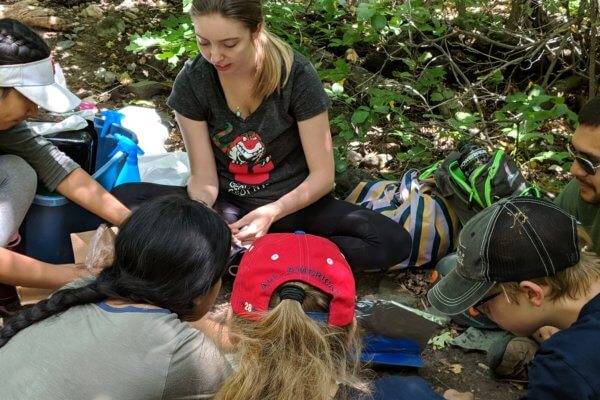
There is growing interest in the scientific community in engaging with the public, but the traditional “deficit model” of one-way communication of scientific facts and figures can fall short of making meaningful connections with audiences.
In an article in BioScience, the STEMAP team describes a new “ambassador” approach to engaging the public. This approach goes beyond the deficit model to encourage open-minded exchange between scientists and the public.
Check out the full article here!
ARIS Fellowship Announced
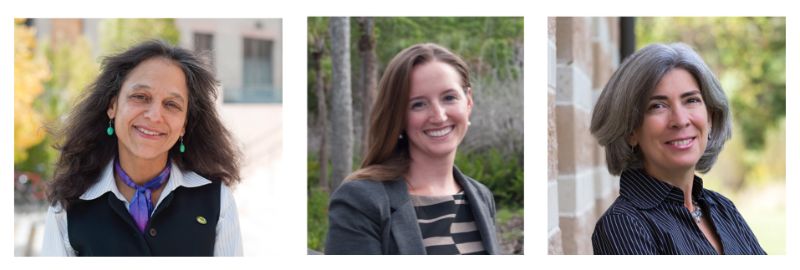
STEMAP Director Nalini Nadkarni, STEMAP Program Manager Caitlin Weber at the University of Utah, and Cat Stylinski at the University of Maryland Center for Environmental Science are excited to have received the Advancing Research Impact in Society (ARIS) Fellowship award.
ARIS is a National Science Foundation Funded program to advance scholarship and partnerships to highlight research impacts in society. Fellows will carry out projects to advance research impacts over the next year.
Click here to learn more about the program!
STEMAP at NABI Conference
STEMAP team members Nalini Nadkarni, Caitlin Weber, and Dennis Schatz presented STEMAP to broader impacts professionals, researchers, and practitioners at the NABI annual meeting in Tucson, Arizona. The team shared the outstanding engagement work of previous STEM Ambassadors and described the training process each Ambassador participates in. Click here to see excerpts from the workshop!
STEMAP offers trainings for graduate students, faculty, and engagement practitioners. Contact us for more information!

Engagement Opportunity – STEM Camporee
Georgia Smith of Learning for Life/BSA Great Salt Lake Council is looking for scientists to help again this year with the Home School STEM Camporee.
The Camporee is on Friday, August 16th, from 10:00 AM to 2:00 PM. Scientists will run 30-minute stations from 10:00 -12:15.
If you are interested in volunteering, please email Georgia.Smith@lflmail.org.
New STEMAP Team Members
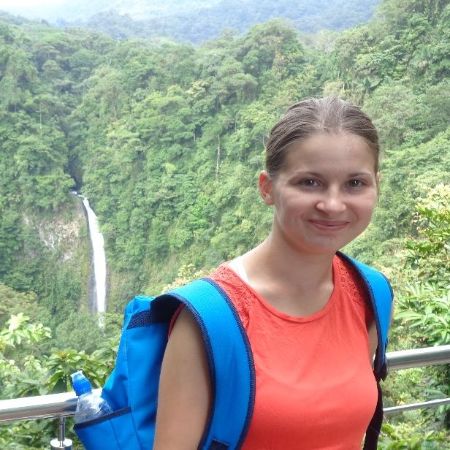
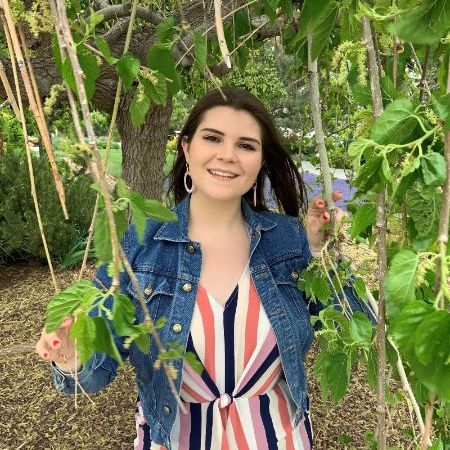
The STEM Ambassador Program welcomes Kassidy Burnside and Katherine Somers to the team! Their assistance with the STEMAP newsletter, research, and administrative tasks will keep the program running smoothly.
Kassidy is a sophomore at the University of Utah majoring in Environmental and Organismal Biology with a minor in anthropology.
She loves animals and plans to use her education in biology to further conservation and research, hopefully as a zoologist or ecologist.
In her free time, Kassidy loves going outdoors, traveling, reading, painting, and writing.
Katherine is a Senior at the University of Utah, majoring in Biology and Psychology.
Katherine is passionate about science engagement within communities and schools and loves volunteering with programs like the STEM Action Center.
In her free time, Katherine enjoys cycling, hiking, camping, and spending time with her sisters. She loves learning new things and expanding her horizons.
Astrobiologists Invite You to Party With the Stars

Have you ever looked up at the night sky and wondered if you are standing on the only living planet in all of that vast space? How would we know if other creatures are out there? The field of Astrobiology is driven by that basic curiosity. This eclectic field pulls together researchers from all corners of science. We approach the existence of life in space from many different angles.
Astrobiologists can be chemists who look at molecules believed to be crucial to early life on Earth, astronomers who hunt the night sky for planets with atmospheres and climates similar to our own, biologists who study how life survives in the extreme ecosystems of our own world, engineers who design the technology to explore the unknown, and so much more. We are a group of astrobiologists from around the world who gather each year to share our work. And we would like to invite you and your family to join us.
The Astrobiology Graduate Student Conference (AbGradCon) is hosting an astrobiology extravaganza on July 23rd. Julia McGonigle, the conference chair, participated in the 2016 STEM Ambassador Program. She is excited to support event organizer Lizethe Pendleton, an astrobiologist in the School of Biological Sciences.
Join AbGradCon on July 23rd 2019 at the Crocker Science Center room 206 at 7:30 PM for this family-friendly event! Ever wondered how the International Space Station makes its own breathable air? Or where life is capable of surviving in our solar system? Make sure not to miss these live demonstrations and activities, as well as ice cream made with liquid nitrogen! At 9 PM, we will move to the adjacent South Observatory to explore the heavens using telescopes.
Please visit www.abgradcon.org for more information or to get involved. If you are unable to attend this event but interested in star gazing, the Physics Department at the University of Utah holds weekly star parties at The South Observatory every Wednesday, year round.
Pratiti Tagore at Genesis Youth Center
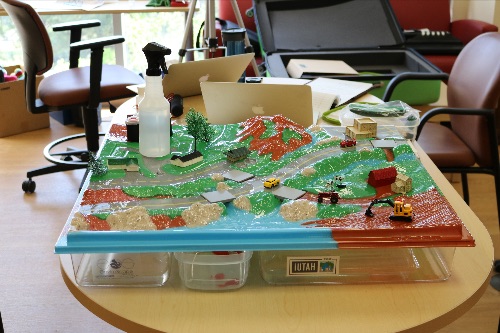
STEM Ambassador Pratiti Tagore visited Genesis Youth Center on Wednesday, April 24th, to discuss water pollution and water conservation with a girls’ youth group.
After a short introduction on her childhood in India, Pratiti and the students discussed water use throughout the world and in Utah.
Participants explored issues surrounding water pollution during a hands-on activity using an “EnviroScape (pictured above). Students considered what pollution sources might exist in a miniature model town, and used water and colored dyes to mimic the flow of pollution sources. Pratiti and the group concluded with a discussion on reducing water use and keeping local watersheds clean.
Thank you to Pratiti and the INSPIRE Staff for a great engagement activity!
Judy Ou Quoted in Salt Lake Tribune
STEM Ambassador Judy Ou and her colleagues disseminated their research on the effects of air quality on childhood cancer survivors during a press event last April. Click here to read about their work in the Salt Lake Tribune.
STEM Ambassador Reflections
Read on for articles written by STEM Ambassadors about their engagement experiences!
Urban Roots and Electrochemistry

By Sagar Udyavara
When I first entered the STEM Ambassador Program, I was interested in exploring the
connection between horticulture and my research as an electrochemist at the University
of Minnesota. While gardening and lab work might seem very different, I saw a connection
between the electrochemical reactions I study and the reactions that occur in plants
during photosynthesis.
I approached Urban Roots in St. Paul, Minnesota with this idea. Urban Roots is a non-profit organization that
supports youth in developing leadership, entrepreneurial, and life skills through
urban gardening and conservation programs. As I learned more about Urban Roots through
reading their website and meeting with staff, I uncovered additional areas of overlap
between my work as an electrochemist and Urban Roots. For example, one of my goals
as an electrochemist is to develop more environmentally sustainable processes to produce
chemicals. Urban Roots also has a commitment to sustainability, which they incorporate
into their urban gardening practices. Furthermore, the skills youth develop in their
Urban Roots internships are directly transferrable to careers in science.
Thus, with input from Urban Roots and STEMAP, I designed an engagement activity for Urban Roots interns to highlight these areas of overlap, convey how electrochemistry can help achieve global sustainability goals, and invite the interns to participate in the scientific enterprise.
So, on a thankfully warm day in April, my lab group members (Tommy, Rocky, Sahithi and Vineet) and I visited Urban Roots to carry out the activity. After a few minutes of preparation, the interns arrived and the test of our science communication skills began. Interns were ages 14-18. I started with an icebreaker to get to know the interns. I then shared how my interests and experiences in my youth led me to pursue a career in science.
I highlighted our shared interest in sustainability and plants by discussing how scientists are looking to plants to develop solutions to help address global warming. I described the reactions that occur in plants during photosynthesis and discussed how scientists can replicate these via electrochemistry to produce products like pharmaceuticals in more sustainable way.
The interns then tried their hand at electrochemistry by building their own “veggie battery.” In groups, they learned about the components of a battery and experimented with constructing batteries from various fruits and vegetables ranging from lemons and oranges to potatoes and tomatoes. We then used the batteries to power a buzzer, a calculator, and even a light bulb! They all did a really great job!
At the end of the activity, we reflected on the skills needed to construct the batteries (e.g., teamwork, communication, problem solving) and compared these to the skills the interns are currently building in their Urban Roots internship.
Overall, the interns seemed to enjoy the activity—one of them even suggested we build an electric car next time using vegetables! My labmates and I really enjoyed our visit and hope to return to work with this group of budding scientists.
Thanks to Urban Roots and the interns for their guidance and participation!
Electrochemistry on the Slopes
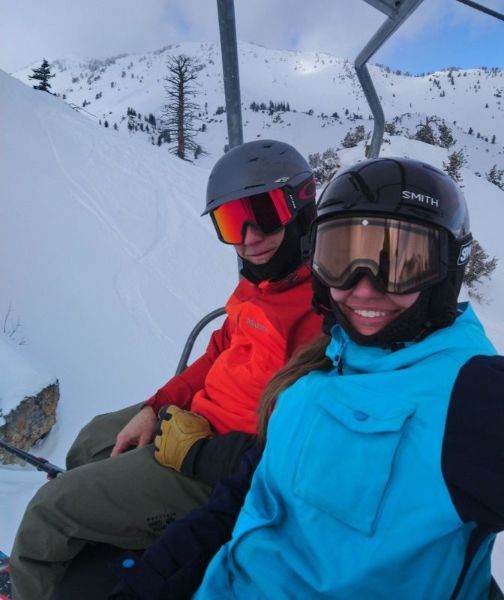
By Ashley Cass, Kasha Lim, Scott Anderson, Koushik Barman, and Dominic Caputo
It is a common misconception that scientists spend every waking hour in the lab, yet many of us at the University of Utah (UU) take advantage of Utah’s world-class skiing. For our public engagement project, we chose to highlight the connection between our electrochemistry research and interest in skiing.
We first engaged with skiers and snowboarders on the “Greatest Snow on Earth.” Similar to an elevator, a ski lift ride offers a 5-10 minute window to engage in conversation with other skiers and snowboarders. Whether it be a local rider or a new visitor, the lift is used by a wide array of individuals.
Although conversations about science are not commonplace in this venue, we thought lift riders might welcome science that is relevant to their day on the mountain. We ignited conversations by offering comments on the electrochromic ski goggles we were wearing.
These goggles use electricity to change the intensity of the tints with a push of a button. We described how the goggles worked and transitioned into talking about electrochemistry research depending on the interest level of our fellow lift-riders. The conversations were often aided by talking about our personal research stories as electrochemists and then relating this to the role electrochemistry plays in everyone’s lives. Even when lift-riders were not interested in learning more, there was always another lift to ride with new people and more skiing to be done.
For our second engagement activity, we worked alongside the UU’s Outdoor Adventures gear rental shop. We set up a table at the shop’s annual end-of-winter gear sale and provided information related to the electrochemistry behind selecting and maintaining batteries for avalanche beacons for backcountry skiing and other outdoor equipment.
During the tabling event, we found it challenging to get the attention of the shoppers. Most people were there by themselves and preoccupied with making their purchases. Faced with the rigidity of the crowd, we found that the louder and more talkative we were at the table, the more interested people became. This event showed enormous promise to reach the outdoor community about how to care for the batteries used in their GPS, beacons, and other recreation equipment.
Modifications to improve the table might include bringing props (e.g., examples of different batteries) and demonstrations to attract attention. We might also strategically place the table at the end of the line to the sale so that we have more time to speak with shoppers or place flyers by the register for shoppers to pick up on their way out.
Both of these engagement activities were low-cost and offered us the flexibility to incorporate science communication into our work. Engaging on the ski lift and at the gear sale allowed us to improve our ability to adapt content to the participant’s interests in real time and engage in meaningful dialogue.
It was a delight to talk with people from all over the world, from novice to expert skiers and snowboarders. This type of engagement will be something most of us will continue to do in the future after our STEMAP experience is over.
The Life Cycle of a Pill
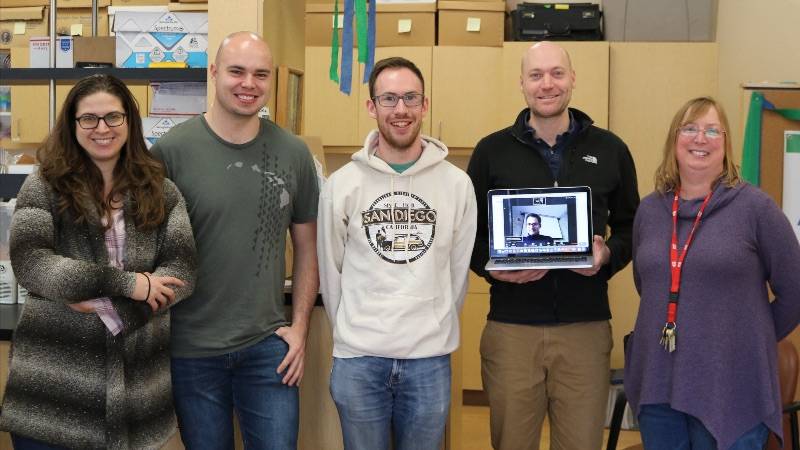
By Victoria Russell, Kevin Klunder, Dominic Caputo, Byron Peters, Christopher Sandford, and Shelley Minteer
On May 15th and 16th the Electrochemical Research teams from the Minteer, Sigman and Baran labs at The University of Utah and Scripps, visited two senior centers: Friendly Neighborhood Senior Center and Riverton Senior Center.
Our motivation behind this collaborative initiative was three-fold: 1) A lot of people have to take medication, especially as one ages, but few are aware of how pharmaceuticals are made; 2) Information about how electrochemistry – our field of study – can help produce pharmaceuticals is rarely accessible to non-scientist audiences; and, 3) Many medications are disposed of improperly, which can have considerable impacts on our water supplies.
We shared the story of Taxol to highlight the role of chemistry in drug development. In 1962, researchers charged with gathering plant samples for cancer research collected samples from a Pacific Yew tree in Washington. Taxol, a chemical in the tree’s bark, was discovered to have anticancer properties. However, the yew tree takes up to 200 years to grow large enough to harvest. Even then, a single tree only yields three doses of the drug. Chemists began working to synthesize Taxol in the lab to make it widely available to the thousands affected by cancer.
To describe how chemists synthesize molecules, we used an analogy between complex molecules and structures made of Lego building blocks. Just like a Lego structure, molecules are all made of simple chemical “building blocks.” To show how even small differences in structure matters, we invited the audience to question whether molecules made from identical building blocks would smell the same. We passed around vials containing limonene and carvone, which are made of the same chemical building blocks. The audience observed differences in how the substances smelled: from ‘oranges’ and ‘mint’, to ‘pine trees.’ We explained that although limonene and carvone have the same building blocks, they smell different because the blocks are arranged in different configurations. Chemists can synthesize complex structures such as Taxol by putting chemical building blocks together in specific configurations. Small changes in how the blocks are arranged can create completely different results in our bodies, just as limonene and carvone have completely different scents.
We described how the same electricity from a wall sockets can be used to perform chemical synthesis through a process called electrochemistry. To demonstrate this, we split water to produce molecular oxygen in a reaction using an electrochemical cell containing a dye that changes from deep blue to dull yellow as chemical bonds break.
Finally we discussed how to deal with unwanted medication. Quite often the body does not absorb all of a medication or medications are improperly disposed of (e.g., by flushing down the toilet). What isn’t broken down by the body or properly disposed of is passed into the water supply. Consumption of water containing waste medication can be harmful to both humans and wildlife. During our presentation, we described how electrochemistry can play an important role in breaking down unwanted molecules into benign constituents. We also directed the audience to nearby drop-off sites where unused drugs are collected for safe disposal.
We enjoyed engaging with audience members at both senior centers and appreciate the opportunity to discuss how chemistry plays a role in everyday life!
About the Blog
Discussion channel for insightful chat about our events, news, and activities.
Categories
Featured Posts
Tag Cloud
- UoG (2)
- Guam (2)
- ethnobotany (1)
- environmental policy (1)
- student immersion (1)
- engineering (1)
- Virgin Islands (1)
- USVI (2)
- lionfish (1)
- children's home (1)
- conservation (1)
- marine ecology (1)
- youth (1)
- sustainability (2)
- Utah (1)
- Arizona (1)
- Nevada (1)
- southwest (1)
- virtual (1)
- project management (1)
- training (1)
- naturalist (1)
- forest (1)
- ecosystem (1)
- Puerto Rico (1)
- Spanish (1)
- library (1)
- Huntington's (1)
- medical science (1)
- Emmanuel Ngwoke (1)
